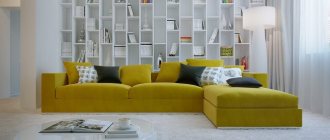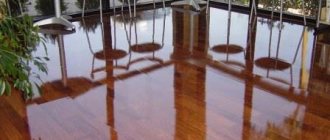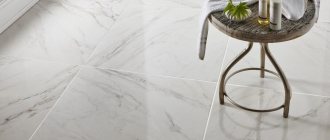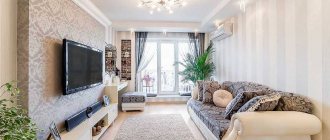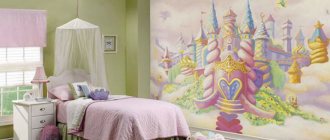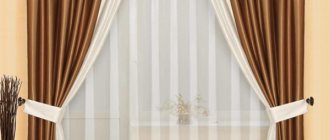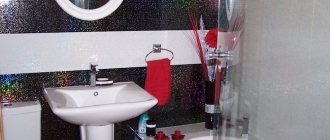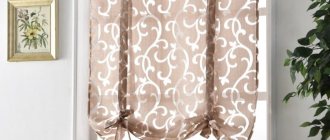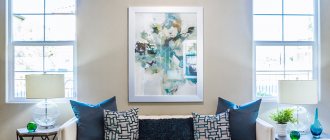Choosing a color scheme depending on the purpose of the room
The selected combinations and density of colors depend on the characteristics of the room - spacious or cramped, high or low ceiling, windows facing north or south. And also on the functional purpose: with what it is customary for a family to combine a living room - with a dining room, with an office, with a guest bedroom.
If the living room is used only for its intended purpose or simultaneously serves as an entrance hall (entrance hall), the preferred color scheme is beige, cream, wood shades. Decorative lamps will enhance the feeling of warmth and comfort and add a few bright touches to the liveliness.
The living room, which is used as a study, can be decorated in English style: muted green and brown tones, furniture with leather upholstery. Likewise, if a home library or bar is located here.
In the living room, which is used as a dining room, “food” colors would be appropriate: caramel, chocolate, coffee. Furniture with the texture of natural wood and cream upholstery is desirable here. For contrasting fragments, it is recommended to choose materials in the yellow-orange range: lemon, orange.
A combination of three colors looks good in the living room: white, brown, beige. With brown it is better to use not a snow-white tone, but “edible” shades: cream, milky. Possible colors for furniture upholstery are apricot or peach. Options for dark inserts - emerald, cherry.
It’s better to have a matte white ceiling: you shouldn’t make it dark in principle, it looks low and overpowering. If there are a lot of thick brown colors in the room, it is not advisable to use a glossy stretch ceiling: it will reflect the interior and look dark. For the same reason, you should not use a ceiling made of mirror panels.
In combination with dark walls, do not install stained glass windows - they have less translucency. It is advisable to laminate window frames (if they are plastic) either monochrome brown or wood-like - the same color as the doors.
Choosing textiles for a brown bedroom
Properly selected textiles will help complement a brown bedroom. Mandatory accessories for windows are beige tulle and thick chocolate curtains. This color ensemble will create additional comfort and allow you to regulate the level of illumination in the room.
More: Ideas for decorating a room for twins
If you need to play up a classic interior, then the curtains should be equipped with fringe, tiebacks and a lambrequin.
A good addition to them would be bed linen and decorative pillows. The following combinations look very good:
- white bed linen with a chocolate bedspread;
- soft turquoise with a variegated blanket;
- pastel linen with dark brown contrast;
- a bedspread with checks or stripes.
Materials and design
The living room in the spirit of classicism categorically gravitates towards natural and expensive materials: marble and granite, other rocks, valuable types of wood, bronze, copper, gilding, velvet and silk, inlays and precious metals.
Floor finishing
For a classic living room, there is no better choice than graceful and elegant artistic parquet flooring. A touch of antiquity, abrasions, and small defects will give it a special sophistication. Moreover, the living room is one of the few rooms in the house where it is really advisable to use natural parquet.
If you prefer more modern interpretations of style or don't want to sacrifice practicality, choose laminate. Nowadays there are a lot of collections that imitate any other materials, textures and patterns. An even more radical alternative is stone slabs or porcelain stoneware.
Wall decoration
In the living room, feel free to take all those wall coverings that are not suitable in the kitchen or hallway. For example, these are paper or textile wallpapers - a combination of natural textures with ornate patterns
Pay attention to wood paneling, tiled mosaics, or combinations of several different materials at once.
Ceiling design
Popular stretch ceilings are not very appropriate in classic interiors, but complex plasterboard structures are easy to use in different ways. If you still choose PVC film, take a satin or matte fabric. And if the even base of the ceiling allows, it is enough to simply whitewash or paint it.
How to choose an interior
A nursery in orange tones requires the right combination of bright and calm shades. To create balance when decorating with orange, it is possible to use gray tones.
Gray pink
What girl doesn't like pink, purple or coral? It is perfect for the walls of a children's room. The gray-pink shade can be combined with pastel or orange tones.
The room will be complemented by decorative items, beautiful curtains and furniture.
Gray-green
This color is considered neutral and suits both boys and girls. The green hue reminds children of summer because it is associated with grass.
Grayish blue
The colors of this option are more suitable for boys' rooms, especially if there are bright accents. Purple shades are good for teenagers to help them concentrate on their studies.
Brown in the kitchen and dining room
In the kitchen, brown is also very appropriate. It not only gives the room an elegant solidity, but also improves appetite, allowing you to get maximum pleasure from your meal.
In addition, kitchen furniture in rich brown shades is quite practical, since the slightest dirt will not immediately be visible on it. A dark brown palette (chocolate, wenge, coffee) is an excellent solution for spacious rooms. Such shades can make the interior luxurious and truly elegant.
For a small kitchen that needs visual expansion, it is worth using lighter shades. The optimal choice would be: beige-brown, caramel, nut and almond colors.
Features of orange color
Strong exposure to too bright a color causes your heart rate to increase and your blood pressure to rise. Therefore, it is necessary to dilute the color with a neutral shade, such as green.
Then the interior will resemble a sunny lawn.
This design option is more suitable for girls, since a cheerful atmosphere is very important for them. Boys tend to prefer when orange is combined with gray tones. To make the orange color easier to perceive, the room is decorated so that this shade is not predominant.
Since a bright shade can invigorate, a nursery in orange is recommended for babies who are too calm.
Advantages
Decorating a living room in light shades has a lot of advantages:
this technique allows you to visually beat the lack of space, which is especially important in small-sized rooms;
Light colors used to create the interior allow you to create different mixes of the texture of finishing materials. They are not limited in the choice of bright contrasts, they provide a wide range of shades, emphasizing strokes, each time changing the visual perception along with replacing the shade of small furnishing elements, for example, furniture covers, capes, sofa pillows, carpeting, wall lamp decor, painting designs.
The main thing is moderation
Orange tones influence the subconscious of children in such a way that they become more emotional and active. The constant overexcited state of a child devastates his nervous system.
Therefore, you should not decorate the room exclusively in orange.
If bright wallpaper is used, it should occupy approximately 30% of the room. The rest should be decorated using neutral shades. You can combine orange with yellow, brown, purple and blue shades.
If the orange tone is neutral and muted, 60% of the interior area is allowed for it. In this case, it is appropriate to choose furniture in calm shades, with elements of green or brown.
For an active child, orange tones may not be used in the decoration of the room. A peaceful environment is appropriate here. A great option if the walls are blue, pink or green, and the children's furniture is orange.
Interior use
Blue tones eliminate any aggression and quickly relax. Light shades (light cornflower blue, turquoise, azure) visually enlarge the room, so they are suitable even for a small room. Deep tones should be used in the form of accents so as not to unnecessarily darken the room.
Since blue is a cool color, it looks better in sunny rooms with large windows, and apartments that face north may seem gloomy if there is too much of it.
You can use color in any room in the house, it is only important to take into account the designers’ recommendations
Kitchen
The kitchen is a room in which blue can be introduced as a background or filling. The walls are decorated in this color if the room is large enough in size and has a high level of natural light. Combinations of gray, white and blue shades are usually used.
You can also make the decor blue: place a kitchen set in this tone against the background of a white wall, apron, and light curtains. A bright, unusual accent will be a cornflower blue refrigerator or a dining area (chairs with a table), although such furnishings can rarely be found on sale.
Living room
Many tones can be combined with blue, and it is in the living room that there is a chance to conduct more bold experiments. If the windows face south, use a blue-gray combination. A blue and white design will be an excellent option for any room, as it is considered classic and will fill the room with coziness and freshness.
You can use blue in furniture by placing a corner or regular sofa, armchairs, or by using covers on upholstered furniture of this color. Bluish textiles will refresh the interior of the hall: curtains, chair covers, carpet.
Bedroom
The atmosphere of the bedroom will immediately become calm and soothing after the introduction of blue shades. It is better to use this rich color in the form of an accent wall behind the bed or use pale bluish tones in curtains, bedspreads, pillows, and various accessories. A perfect color for a Mediterranean-style bedroom.
Children's
The combination of blue and white in the nursery will also be very successful, because kids like marine themes. To prevent the atmosphere from seeming boring, green, yellow, orange, and red colors are also introduced into the interior as accents. For modest children prone to apathy, bluish shades cannot be used in large quantities, but on the contrary, they will calm a hyperactive child. In teenagers' bedrooms, beige or light brown colors are usually used rather than white.
Bathroom
It is not recommended to decorate the entire bathroom with blue tiles: the room will turn out too gloomy. It is better to decorate the floor, one of the walls in this color, and lay out random ornaments and drawings in tone on the rest. Against a light background, a cornflower blue sink and toilet look original, although it is not easy to find such plumbing fixtures on sale.
There are some features of introducing blue into the bathroom interior:
- If the color is too saturated, always dilute it with warm and pastel tones;
- combine blue with shades of natural wood;
- add elements from other natural materials to the interior, for example, rattan, wicker, marble;
- decorate a small room in blue tones, using rich blue only in the form of accessories;
- use more glossy surfaces - they bring the interior closer to a marine theme.
Hallway
Dark colors are only suitable for well-lit, open rooms. As a rule, there are no sources of natural light in the corridor, so the wallpaper here can be made sky blue, azure, light cornflower blue, not darker. A cabinet made of light wood and other wooden decorative elements will look beautiful.
A color scheme
The condition for yellow in a children's room is its limited use. An even distribution of shades will create an atmosphere that will set a positive mood, and not irritate or tire the child.
In such an interior, combinations with the following colors and their shades are interesting:
- blue - a classic option for a nursery. To make it more original, it is recommended to use turquoise or sea green;
- green – the most natural and organic connection. It does not tire or irritate even in a fairly bright design. The color of green smoothes out the brightness and riot of yellow. To reduce contrast, you should take softer shades - olive, salad, mint. This color balance is harmony, comfort, freshness and incredibly bright energy;
- orange - a warm color that is perfectly perceived visually and is psychologically comfortable, but is also recommended for use in the interior to a minimum. It can be replaced with red-terracotta, which will give the room an unusual flavor;
- lilac is a very cute combination, more suitable for a girl. You can adapt such an interior for a boy using appropriate accessories;
- gray is the most gentle and calm combination for a newborn, although age and other limits are not set here. Light translucent tones work well in any lighting;
- chocolate - best seen in the combination of “yellow surfaces - dark brown furniture”, complemented by contrasting accessories.
The combination of different shades of yellow looks interesting. This color is very rich in shades - from rich gold to cold lemon. Therefore, it is not difficult to find a reasonable balance for it. In this case, you should take into account the side where the children's windows face: for the sunny side, cool tones of the color itself and its combinations are more suitable, for the north it is better to use saturated shades.
Spot use
Types of structures
When choosing a design, it is important to take into account many nuances: find out the dimensions of the room, determine for what purpose you need a sofa. Depending on the purpose, there are two main types of structures:
- Modular. This type is good because you can choose the elements that will make up the sofa, its size and the number of seats. During use, you can change the shape of the structure as you wish, moving and combining individual elements with each other.
- Folding. This type is more compact, but no less practical. There are several types of folding structures, they are transformed in different ways. If necessary, the folding design will easily provide you with an additional sleeping place.
Both designs can be either straight or angular.
The healing properties of orange
A child can benefit from orange color in a children's room if he is going through a difficult period. Under the influence of the shade, it is easier for a child to cope with problems; he will feel a surge of energy and strength necessary to overcome difficulties.
Thanks to the orange interior, there is energy that needs an outlet. At these moments, girls show good creativity.
For example, it could be dancing or drawing. It is better for boys to burn off energy through physical activity. Therefore, a punching bag or rope in his room would be appropriate.
It is very good that orange color can awaken energy, but the main task of parents is to direct it in the right direction.
Ideally, a couple of weeks after the renovation, the child will begin to attend clubs and sports sections, take walks during the day, and set aside time in the evening to read books.
Finishing ceilings, walls and floors
The decoration of walls, floors and ceilings does not depend much on the main palette, but here some nuances must be observed, especially if the design includes a gradient or another transition of shades.
For the floor, it is best to choose linoleum, ceramic tiles, or make it self-leveling. These materials are easy to clean, resistant to wear and tear, and retain their decorative appearance for a long time. Laminate is susceptible to water damage, although its surface is less contaminated than traditional wood planks or parquet. Traditional materials have a limited selection of shades, unlike modern ones, where the choice is very extensive.
The first place among finishing materials for walls is traditionally occupied by wallpaper, despite its short service life and the fact that it is easy to get dirty. Painting is considered the most practical, since painted walls can be easily washed when the need arises, and a modern living room made in white or any light colors will often require cleaning.
Stretch ceilings designed in light colors are an excellent solution for modern decoration of a living room in a modern style. They are very functional and are successfully used on uneven surfaces. Ceiling coverings of this type stretch very quickly, and the stretch ceilings themselves can have a glossy or matte surface, with or without a pattern.
Boy's room
Boys prefer a different color palette than girls - more contrasting. Among the designs for boys' children's rooms, the most popular colors are: blue and all its shades, as well as the entire spectrum of green.
A children's room in green is suitable not only for boys, but also for girls. By choosing this color scheme, you can immediately solve several main problems. As you know, green color calms and brings an element of harmony. This is only beneficial for boys, as they are very active by nature.
One of the alternative solutions to green could be light green. He has the same positive qualities.
The color of the nursery can be blue, but it is preferable to choose a shade of it, for example, blue. It is suitable for less active children; its main feature is an increase in performance. It would be great to paint a schoolchild’s room this color.
These two colors can be combined, therefore, when choosing one of them, parents automatically use the second color in the additional arrangement. The area for relaxation or games can be decorated with green, but the workplace should be in blue. In such a room it is necessary to have indoor plants - they will support the overall idea.
On video:
room design option for boys.
Features of a living room in beige color
Beige color has many shades: light beige, creamy beige, peach, nut, cocoa color and many others. Each of these shades is widely used when decorating living rooms and is very popular among professional designers. Beige shades have deservedly become design classics, because it has been proven that they have a beneficial effect on the human psyche, calming his nervous system. Decorating a living room in beige has a number of advantages:
- Ease of combining this color with other shades.
- Using light shades you can visually increase the area of the room.
- This color never goes out of fashion, maintaining its relevance throughout the centuries.
- Shades of beige fit into any interior style; they are universal, but at the same time help to give the living room a zest.
- These colors look advantageous both in daylight and in artificial light.
More effectively, beige shades in the living room will be combined with colors such as brown, purple, black, green, red and gray. But the absolute classic is beige combined with brown.
What styles can a beige living room be designed in?
Due to its versatility, beige color will be appropriate in the following areas:
Classic
Here it is important to remember symmetry, conciseness and severity of lines. When choosing beige wallpaper, make the floor dark
This rule also applies to furniture; beige upholstery is best framed in dark colors. Classics do not accept diversity; choose the basic shades that will be used in decoration. Country. This style, like no other, gravitates towards naturalness. What if the color beige does not represent the natural, the natural and the natural. In a country living room, this color serves not just as a background, but it is also actively used in accessories, furniture, and textiles. It can only be diluted with brown shades, but in no case with pink, purple or red. Natural stones and dried flowers can be used as accents that will enliven the interior.
Minimalism. Beige color combined with minimalism is an ideal solution for small living rooms. A minimum of functional furniture in light shades will visually expand the room, and a few bright accents can add a certain zest to the design. Modern. A beige living room in Art Nouveau style will become a real work of art if you carefully think through the accents. Textiles, an unusual carpet or vases can become spectacular spots in a calm interior. Colors should complement each other, but it is important to achieve balance and “crush” one color with another. High tech. Despite the fact that sometimes rich colors predominate in this style: blue, red, black, white, most often preference is given to beige shades in combination with gray. It is this ensemble that is able to focus on ultra-fashionable design with modern technology. This style involves the use of glass, metal, and mirror elements, which, in combination with beige color, will make the room stylish and exclusive.
Red
The color red excites the psyche and can lead to fears, aggression, and nightmares. But as accents, red can be used in the interior of a nursery.
Beige or white colors can perfectly smooth out the aggression of red. Red will harmoniously fit into the interior of a child's room in a nautical style, and teenagers will like a room in the pop art or oriental style.
From monochrome to avant-garde
If you look at the photo of a living room in a classic style, you will notice that not only the walls, ceilings and floors are made in beige tones, but also the furniture
However, if you pay attention, all items are presented in different colors. Furniture is slightly darker than walls and ceilings
And paintings and other tabletop items have dark brown and yellow frames. This style is called monochrome and involves a combination of smooth glossy and matte surfaces with convex or rough materials. This can be wallpaper with fragments of silk-screen printing on a relief background, or patterned convex furniture upholstery. The wood pattern of the flooring, the roughness of the plastered ceilings, the smoothness of the marble surfaces of the fireplace - all of this serves as a decoration for the room. Even a non-professional can complete such a simple design.
The sandy ceiling and wallpaper on the walls will come to life with floor vases and sofa cushions in bright oranges and bold yellows. With them, any room will seem warmer and more comfortable. And if you are a lover of coolness and seascapes, then the interior of the living room in beige tones can be enlivened by blue and blue additions in the form of accessories, glassware or paintings. The greenery of indoor plants will enliven a seasoned style and add a little freshness. Don’t be afraid to add other colors because of the uniqueness and conservatism of the beige tone.
All shades of red, lilac and purple can give the room a festive look. For example: lilac armchairs and a purple sofa will add a bright note to the monotonous and calm look of your room in a classic style. To visualize such a bold idea, we have placed below a photo with colorful furniture. Anyone who loves avant-garde style and originality can enjoy the designers’ ideas and turn them into reality on their own territory. It cannot be said that light furniture is suitable for a married couple with children. It is bright and dark furniture that will hide small stains that are inevitable in the presence of children and pets. The main thing is not to overdo it with colors so that the main beige background prevails. And the bright additions were not numerous.
Exposure to orange.
This tone seems to be created for less active children who tend to withdraw into themselves. The orange color will awaken in the child the desire to act, to create and make something, the blues and depression will gradually disappear, and soon they will be completely forgotten.
If the baby on the contrary is very active, then the orange color will cause a storm of emotions in him, and an incredible flow of inexhaustible energy, which is why for such children an orange nursery will not be the best solution, in this case it is better to take a closer look at calmer and pastel colors.
In general, if we talk about the impact of the orange palette, then we can say for sure that this color can charge you with missing energy, kill a bad mood, set you in a positive mood, visually warm you up and awaken creativity.
Children's room in orange, photo.
Probably everyone knows that each primary color has many shades, which can be brighter, paler, lighter or darker. Below, in the photo you can study the variations of the orange color, ranging from a bright true orange tone to muted ocher or bronze.
What tones to combine orange with in a children's room.
In its pure embodiment, the orange color looks too provocative, so it is better to dilute it with some less active shades. For example, orange furniture should be placed against a background of gray, white or beige walls. By the way, the option with gray walls is considered one of the most correct, since the gray palette is able to control and absorb the brightness of the orange tone.
In addition, orange walls with white furniture or combined orange and white wallpaper on the walls and natural brown tone of furniture can be considered successful and harmonious variations.
Calm green furniture against the background of white and orange walls is perceived more than positively.
Orange furniture (bed, wardrobe, table) with yellow or green inserts, as well as textiles, looks very impressive. But in this case, the shade of the walls should be as neutral as possible, namely gray or beige.
The fashionable color of wenge furniture is what you need for the right interior; such furniture will look great with walls painted in an orange tone.
Blue and dark blue colors will also harmoniously fit into the design of a nursery made in orange. In this case, there are several variations, namely:
- Blue color may be present on the walls, then the furniture is selected in an orange tone;
- Furniture can be blue, then the walls are covered with orange wallpaper;
- Furniture can be orange-blue, then the walls are made in a third, unobtrusive range - beige or gray;
- The wallpaper on the walls can be orange-blue, then it is better to select furniture in light colors, for example gray or beige.
An orange children's room made in different pale shades of orange, green, cream and yellow will look both unobtrusive and positive.
Orange children's room, photo.
Bright colored children's room:
The orange color in a children's room serves as a clear example of what modern, bright and stylish interiors should be. In such a room, the child will certainly want to spend time, play with his favorite toys, watch cartoons or do homework. By the way, about lessons, it is known that the student area in the children's room, decorated in orange, promotes the desire to complete homework.
The “Comfort in the House” website reminds its readers that you can subscribe to receive news from us, the subscription form is in the sidebar, subscribe!
An orange children's room can influence the psychological state of a child. The brightly colored interior evokes positive emotions.
Pastel shades are reminiscent of the sun; they have a calming effect on the baby, like an antidepressant.
This shade is called the color of joy. Just look at the photo of the orange children's room to feel it.
Reasons for popularity and color features
Brown sofas are very popular not only when decorating the interior of a living space, but also in offices and study spaces. The furniture has the following advantages:
- good compatibility with most styles;
- a large number of varieties, designs;
- brown furniture is produced by almost all well-known companies;
- external respectability (especially for leather models);
- creating a cozy, warm atmosphere;
- color is used in budget and luxury models;
- looks natural.
Brown color has a calming effect. There is a rich palette of shades from light brown to dark chocolate. Depending on the interior design style, sofas in the following colors are used:
- Beige-brown. It is versatile, very delicate and visually increases the space of the room.
- Taupe. Suitable for any style solution.
- Dark brown. It has strict lines and a discreet design, so it is perfect for decorating an office.
- With a reddish tint. Such furniture has an unusual appearance, so it can become the main element of the interior.
Dark brown
Beige-brown
With a touch of red
Taupe
Benefits of brown
- Color is used to decorate interiors in different styles. For example, the shade is suitable for classic and Scandinavian aesthetics; it is also basic for eco-style, country, chalet, rustic and many others.
- Housewives love the color for its non-staining qualities: dirt is invisible on it, and accumulated dust is not very visible. It is also able to hide splashes of water, light limescale deposits, and fingerprints. Therefore, you can worry less about someone noticing a little mess.
- Designers often use warm colors in rooms where there is not enough sunlight. For small bathrooms this is a plus.
- Brown is also the color of wood, so by choosing this material, you automatically use the named tone for decoration. And natural or artificial materials like wenge, walnut, bamboo or other types of wood emphasize the status and elitism of the environment, since the listed varieties are quite expensive.
Instagram @lainternarredamento
Instagram @the.designer.in.you
Pexels
Instagram @antoshchuk.design
Instagram @antoshchuk.design
Instagram @antoshchuk.design
Adviсe
Some useful points that will help you choose the best combination of colors in the living room interior:
- Don't be afraid to use bright colors. Let's say you have furnished your living room in a classic design, using brown, noble beige and a little green. And everything is beautiful and dignified, but something is missing, there is a feeling of a slightly boring space. So spice up this color selection by adding unexpected pops of orange or pink. Turquoise, warm yellow and other bright contrasting shades may be suitable. Decorative pillows, wall panels, sofa upholstery and other decorative items can be made in this accent color. And you will see how the walls and furniture in the living room will sparkle, the interior will become warmer and more interesting.
- Deep blue color goes well with berry tones. Why not try decorating the walls and furniture of the living room in a blue and burgundy version with an accent, for example, in a dark green version. Only the colors should be muted, warm, natural shades, and not neon or acidic. A living room in a similar design takes on a luxurious look: the color of the walls, the upholstery of the sofa, the shade of the curtains - everything will look harmonious. At the same time, such a selection will delight with its thoughtfulness and decorativeness.
- If the living room has a strict black and white design, then you can decorate its walls with bright colors of red or yellow, or add a little green. You will see how much the interior will change after this; the living room will immediately take on a lively, warm look.
- It is better to choose warm and soft colors for wall decoration, curtain colors and sofa upholstery rather than cold ones. A living room decorated in warm colors always looks more cozy and comfortable. Beige and orange are always visually more comfortable than lilac or cool blue.
- You can try this rather bold option: paint the entire living room in light mint-sand shades. And as a contrasting tone, add dark beige, turquoise or add bright green. Such a living room will be a real source of pride for the owners and an ideal place for relaxation and meeting with friends.
- Don’t use too many details in a contrasting color - one large or two or three small ones will be enough to highlight the main decoration of the room. For example, in a grayish-beige living room, one bright red large sofa or several small pillows and a painting on the wall in a contrasting color will look great.
- The more natural the basic colors of the floor and walls, the more daring experiments with contrasting shades of curtains and sofa you can afford.
Whatever color combination you choose, do not forget to adhere to the rule of proportionality between contrasting and primary colors - and, without a doubt, even your own living room design will look great.
https://youtube.com/watch?v=_MezU8D04Uc
https://youtube.com/watch?v=3ZmwjO9eO_Y
Why is turquoise good?
The turquoise palette has several shades, each of which has its own color characteristics. This allows you to use turquoise decoration in rooms of different layouts and with different levels of lighting. In gloomy rooms of small areas, light turquoise shades are appropriate. With their help, you can expand the space and fill the decor with lightness and lightness. Delicate shades of turquoise add depth to the space and also make the nursery look voluminous and spacious. For hyperactive children, the room should be decorated in turquoise tones with greenish tints. Turquoise and blue in the interior of a nursery will help to quickly restore strength. These shades also have a beneficial effect on children's immunity.
children's room in turquoise tones
Your baby will never get tired of a turquoise children's room.
Why? Because turquoise is a chameleon color. Being the main background of the decor, it will be perceived differently each time. Everything will depend on the degree and type of lighting in the room and the correct selection of companion colors. For example, when adding blue flowers to the decoration, turquoise will also have a blue tint. In general, turquoise color is in perfect harmony with the rest of the rainbow palette. Children's rooms turn out to be very “alive”, where contrasting colors are added to turquoise, such as:
- Hot pink.
- Fiery orange.
- Rich yellow.
- Brick brown.
bright pink color will “revive” a children's room in turquoise color
The main thing in contrasting combinations is to maintain a harmonious balance. Bright accents in the nursery should be no more than a third of the overall background of the interior. Turquoise can also be combined with pastel shades. In such a room, cleanliness and freshness reign. Try to highlight the beauty of turquoise color with white splashes, and the decor will delight you with space and brightness.
Successful combinations
Walls, furniture, curtains should not be chosen in gray tones. You will need a spot of color that will enliven the interior of the room. If gray is the main one, then you can choose others in contrast. But you shouldn’t take more than 3 tones.
With white
The combination of white and gray in the bedroom is ideal as it has a relaxing effect. In a small room, more white is needed, and saturated shades are chosen from gray shades. Geometric patterns and abstractions on walls and pieces of furniture will look interesting. The emphasis on the white bed distracts from the fussy base tone. Snow-white tulle curtains and a light carpet will complement the bedroom design. You can contrast white walls with furniture in gray tones. A bed with a textile headboard will provide special warmth, and a small rug will complement it.
With pink
The severity of gray in the bedroom can be softened with pink. Pearly colors are ideal next to powdery tones. Fuchsia accents liven up the light gray walls. Here you should not overdo it with pink, otherwise sophistication will turn into excessive naivety. It is enough to include 30% of the tone of a girlish blush.
With blue
Playing with the color blue will help refresh your bedroom. Even one contrasting spot, like a blue vase, can bring out the shades of gray and ash in the room. The price of neutral furnishings will increase if you combine adjacent tones of blue and grayish.
With yellow
The color of stone and concrete makes the bedroom gloomy. And golden yellow will add light. But do not overdo it with yellow trim, otherwise the harmony of the interior will be disrupted. It is better to accentuate the textiles of the room with yellow. You can choose gray-yellow prints on walls, carpets, paintings.
With brown
Gray can be partnered with all shades of brown in the bedroom. Dark or light, they will delimit the zones of the room. If the bed is in a romantic haze, then the linen closets are made of natural dark wood. A dry interior will become warm when combined with a brownish floor. Rug patterns and picture frames will also make your bedroom feel cozy.
With blue
The gray-blue palette of the bedroom will add vigor in the morning. A cold combination is especially recommended in rooms facing southeast or south. Neutral colors relax you after an active day at work. In such an environment they relax emotionally.
Interior items
Furniture in yellow color is usually used only for small children. From the age of five, more adult models of classic colors will suit a child. You can leave one bright large object (for example, to “light up” a dark corner of the room), and for the rest use this color only as a finishing element. In a nursery for two children, the doors of a common closet can be decorated in different colors, for example, yellow and blue.
There are no such strict requirements for accessories. When using them in a children's room, you can choose several shades and combinations of yellow at the same time, which will make the space more lively and cheerful. If something no longer suits you, you can change accessories to suit the child’s mood.
The easiest way to decorate a room in yellow tones is to add textiles. Curtains, drapery, carpet, bed linen, and bedspread are suitable. The girl will be pleased with the design elements - decorative pillows. Even small inclusions of such shades in the interior will help the child to tune in positively, improve well-being and develop a lot of creative abilities.
In design, a combination with light green color is often found.
Successful combinations with other colors
Designers use brown tones so that they do not create a gloomy mood. Compositions with other shades are needed to create color unity in the living room.
With green
The tones of wood and foliage look organic together. In a brown living room, the colors of swamp, moss, and pistachios are appropriate. Emerald and malachite shades are used in classic interiors. Green tones give the room more freshness. You can place indoor plants on shelves and window sills in the living room. Textiles in greenish tones are used: pillows, blankets.
With blue
Rich brown colors in the room are successfully combined with sky blue. It is best if the walls are painted turquoise, ultramarine or azure. Then the flooring and furniture choose the colors of tree bark. The beige walls are in harmony with the pure blue plastic on the furniture.
With yellow
Brown shades are close to yellow and golden tones. Rich tones of yellow are used in the selection of textiles and accessories. In the chocolate living room, golden silk curtains are hung on the windows. You can experiment with the ceiling by painting it in the colors of the sun. Then there will be more space.
With gray
The combination of gray and brown is ideal for Scandinavian style. The background for the living room is white. Upholstered furniture made of natural wood can be covered with shaggy gray wool blankets or fluffy pillows. The coldness of gray is lost in the warmth of brown, giving the room a cozy feel.
Coffee with milk
Coffee color is chosen as the predominant color in the design of the living room. It harmonizes with the sandy tones of textiles and the richness of brown in furniture made of natural wood.
The interior becomes luxurious if you use chocolate-colored trim and light coffee-colored furniture. Appropriate textiles and lamps are selected for it. It is best to make the wall behind the back of the sofa a single color by choosing either a dark or light shade of wallpaper or panels. The pattern on the textiles should match the color of the wall decoration.
Brown
When choosing a color to decorate a child's room, brown is the last thing that comes to mind. However, if you use brown in the form of wood, you can create a sophisticated, cozy interior. Wood in brown shades creates a feeling of security.
To prevent the interior from putting pressure on the child, add more bright and light elements.
- For a young captain, decorate a room in a nautical style, imitating the interior of a ship's cabin. Dilute brown wood with blue and white textiles.
- Boys also like the pirate style. It is useful to add gold elements, natural linen, and burlap.
- A Western room is an adventurer's dream. Scarlet splashes, leather and suede in the interior, checkered textiles and even denim are allowed.
- Do you want to instill in your child a love of nature? Choose a safari style for your children's room. Combine light sand, beige, brown shades with natural green tones, use animal prints.
- A teenage girl will love the romantic interior in country style. Use light brown shades of wood, floral prints, openwork elements and ruffles when decorating textiles.
- For a teenage boy, offer an interior in a classic English style. Details will help you feel like a real gentleman: an image of the Tower of London, a double-decker bus or a telephone booth.
Be sure to consult with your child when planning renovations in the nursery. Perhaps the baby will categorically not like the color scheme that seems most acceptable to the parents. Well, teenage children can independently develop a room project, gaining not only a stylish interior, but also the skills of a designer.
5 488
You can share or save the article for yourself:
There are no comments yet, but you can write your opinion or ask a question.
About shades
Green color is universal. Suitable for decorating a room for girls, boys and children of different sexes. It has a calming and anti-stress effect on the child’s psyche; it has a positive effect on increasing performance, which is important for schoolchildren.
Shades of the primary color and their combination with others open up a whole space for experimentation in the design. The color can be warm if it is more yellow-green, cool if it is bluish. Warm shades increase activity, while cool shades soothe. The choice should be made depending on the child’s temperament.
- Olive creates a neutral, calm atmosphere, but gives the interior a certain restraint, since it strongly absorbs light. It goes well with white and beige. Also, in an olive-colored nursery, you need to carefully consider the lighting.
- Interior design in mint tones looks gentle and airy. This color does not overstrain the eyesight and psyche. Mint goes well with white, yellow,...
- Blue-green, jade – bright and rich. If you use it with lighter, calmer tones, then the room will look cozy and filled with energy. The shade goes well with the beige palette.
- Yellow-green and light green will fill the nursery’s interior with light, a charge of vigor and optimism. Despite its brightness, it does not irritate the eyes. It is recommended to use it in shaded rooms, for example, with windows facing north.
The uniqueness of color and its shades lies in the ability to organically blend into the interior without having a significant visual impact on it: it does not reduce space or make objects heavier.
The use of green in the nursery also applies to indoor plants. You need to consider how they will be combined with curtains, walls, furniture upholstery, wallpaper and accessories. Contrasting solutions will bring freshness to the space being arranged.
Beige and white color
The impression of cleanliness, freshness and order arises in rooms that are designed in white and beige tones. This interior is calming and creates a feeling of spaciousness.
If the living room is decorated in a white and beige palette, then to decorate the walls it is better to use brownish or yellowish shades of beige, which will warm and give comfort to the room. A snow-white sofa, especially a leather one, or a wall of furniture would be appropriate in such a room, as well as chrome parts - they will add relevance to the interior. If wooden elements are used in snow-white furniture, the interior acquires the nobility of antiquity. The combination of a beige and white interior with bronze accessories looks interesting.
White linen curtains or a smooth carpet look great in such a room.
Classic: beige and brown
Brown and beige are an ideal solution for a bedroom, a cozy living room, hallway, office and kitchen. Brown is rich chocolate and dark coffee shades, the color of walnut and oak, and the golden tones of chestnut.
In the bedroom it would be appropriate to match the light beige walls with dark parquet and noble dark furniture.
Dark brown wooden wall panels and parquet in combination with beige ceiling trim, curtains, and carpet create a working mood in the office. A home library looks great in these same colors.
A kitchen with a beige-brown palette will become the most sophisticated and cozy place in the house.
